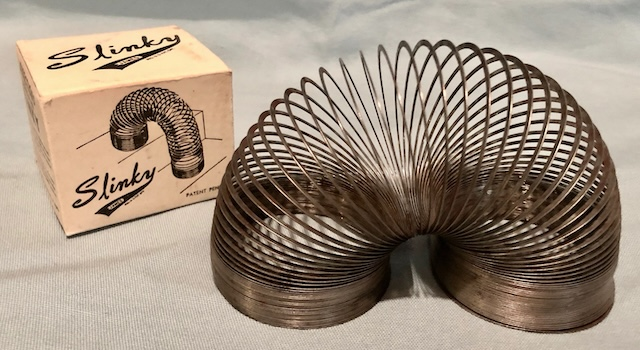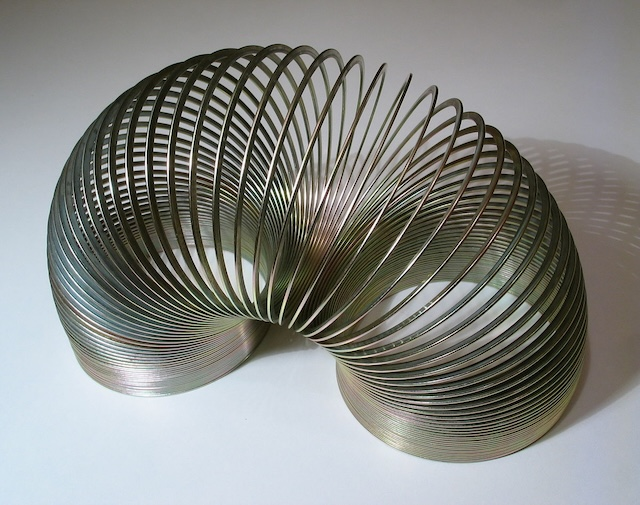Some toys don’t need batteries, lights, or screens to be memorable. All they need is a little movement, a simple design, and a whole lot of charm. That’s exactly what made the vintage Slinky toy one of the most beloved playthings of the 20th century. If you grew up watching this coiled spring “walk” down a staircase, you’re not just reminiscing—you’re remembering a piece of pop culture history.

The Accidental Invention That Sparked Joy
In 1943, a mechanical engineer named Richard James was working at a shipyard in Philadelphia when fate stepped in. While experimenting with tension springs for naval equipment, he knocked one off a shelf. To his amazement, the spring didn’t just fall—it “walked” down. That moment of accidental magic led to the creation of the Slinky.
With the support of his wife Betty James, the couple turned that fluke into a phenomenon. Betty came up with the name “Slinky,” inspired by a Swedish word meaning “sleek” or “graceful.” The toy made its debut in 1945 at a department store in Philadelphia, and it sold out almost immediately.
Video: Watch the video How This Guy Mastered the Slinky | Obsessed | WIRED to discover the fascinating art of mastering this iconic toy.
Why the Slinky Was So Irresistible
The beauty of the vintage Slinky toy lay in its mesmerizing movement. A tightly wound metal spring could “walk” down stairs, stretch and bounce with ease, and entertain for hours without any assistance beyond gravity.
You didn’t need instructions. You didn’t need batteries. All you needed was a small staircase or even a slight incline. And watching it move was oddly satisfying. It was like watching a magic trick unfold—only it was science doing the work, not sleight of hand.
Behind the Magic: The Simple Science of the Slinky
The Slinky’s ability to “walk” is a fascinating blend of physics and design. When placed on a stair, its front end drops while the back stays on the step. The spring’s momentum and its shifting center of gravity allow it to flip over itself repeatedly, creating a continuous walking motion.
The smoothness of that motion, the metallic rhythm of the spring tapping each step, and the almost hypnotic sway made it a sensory experience as much as a visual one. Kids didn’t need to understand the science—they just knew it was fun.
A Household Must-Have in the Mid-20th Century

By the late 1940s and 1950s, the Slinky had slinked its way into nearly every American household. Affordable, durable, and endlessly entertaining, it became a go-to gift and a favorite in toy boxes everywhere.
What made it especially unique was its versatility. You could walk it down stairs, stretch it between your hands, twist it, flip it, and invent your own games. Unlike toys that were tied to television shows or marketing gimmicks, the Slinky stood on its own. It didn’t need a character or a catchphrase to sell—it had movement and magic.
A Cultural Phenomenon That Reached New Heights
The Slinky wasn’t just a toy—it became a cultural touchstone. It starred in commercials with catchy jingles. It showed up in movies, cartoons, and even scientific demonstrations. In the 1990s, it had a memorable role in Toy Story as the lovable Slinky Dog. It also became a classroom tool to teach physics concepts like waves, motion, and energy transfer.
Over 300 million Slinkys have been sold since its creation. That’s more than the population of the United States. It’s proof that even in a high-tech world, there’s something magical about a simple spring doing what it was accidentally designed to do.
From Obscurity to Nostalgia and Back Again

Like many vintage toys, the Slinky experienced a lull in popularity during the rise of electronic games and TV-driven toy lines in the 1970s and 1980s. But it never fully disappeared. In fact, its nostalgic value only grew stronger.
By the 1990s, adults who had grown up with the Slinky began sharing it with their own kids. Collectors hunted down vintage editions. Toy stores stocked new versions—some made of plastic, some rainbow-colored, some oversized. But all of them kept the original spirit intact.
Today, the vintage metal Slinky remains the most sought-after version. Its original weight, design, and movement feel just a bit more authentic than its plastic successors.
Fun Facts You Might Not Know About the Slinky
Video: Watch the video The Invention of the Slinky Toy | The Story of Richard T. James | The Dr. Binocs Show to learn about the fascinating history behind this classic toy.
- The original Slinky cost just $1.
- The Slinky was used in Vietnam to create temporary radio antennas.
- Betty James took over the company in the 1960s and made the Slinky a national treasure.
- The famous Slinky jingle (“It’s Slinky, it’s Slinky…”) is one of the longest-running advertising jingles in history.
- A Slinky can stretch out over 80 feet without breaking.
Why the Slinky Still Matters
In an era of apps and algorithms, the Slinky is a reminder that the best things in life are often the simplest. It represents a time when imagination did the heavy lifting and fun wasn’t manufactured—it was discovered.
The vintage Slinky toy isn’t just a throwback—it’s a symbol. A symbol of childhood wonder, of invention born from error, and of the joy that lives in small, bouncing steps.
Conclusion: A Classic That Keeps on Walking

The Slinky might have started as a mistake, but it became one of the most iconic toys of all time. Its charm lies not in its complexity, but in its simplicity. It teaches kids about motion and gravity while keeping them smiling. It brings adults back to a simpler time. And decades after its creation, it still hasn’t lost its magic.
So if you recognized it instantly, you’re definitely someone who appreciates the classics—and knows that sometimes, all it takes to create wonder is a spring and a staircase


